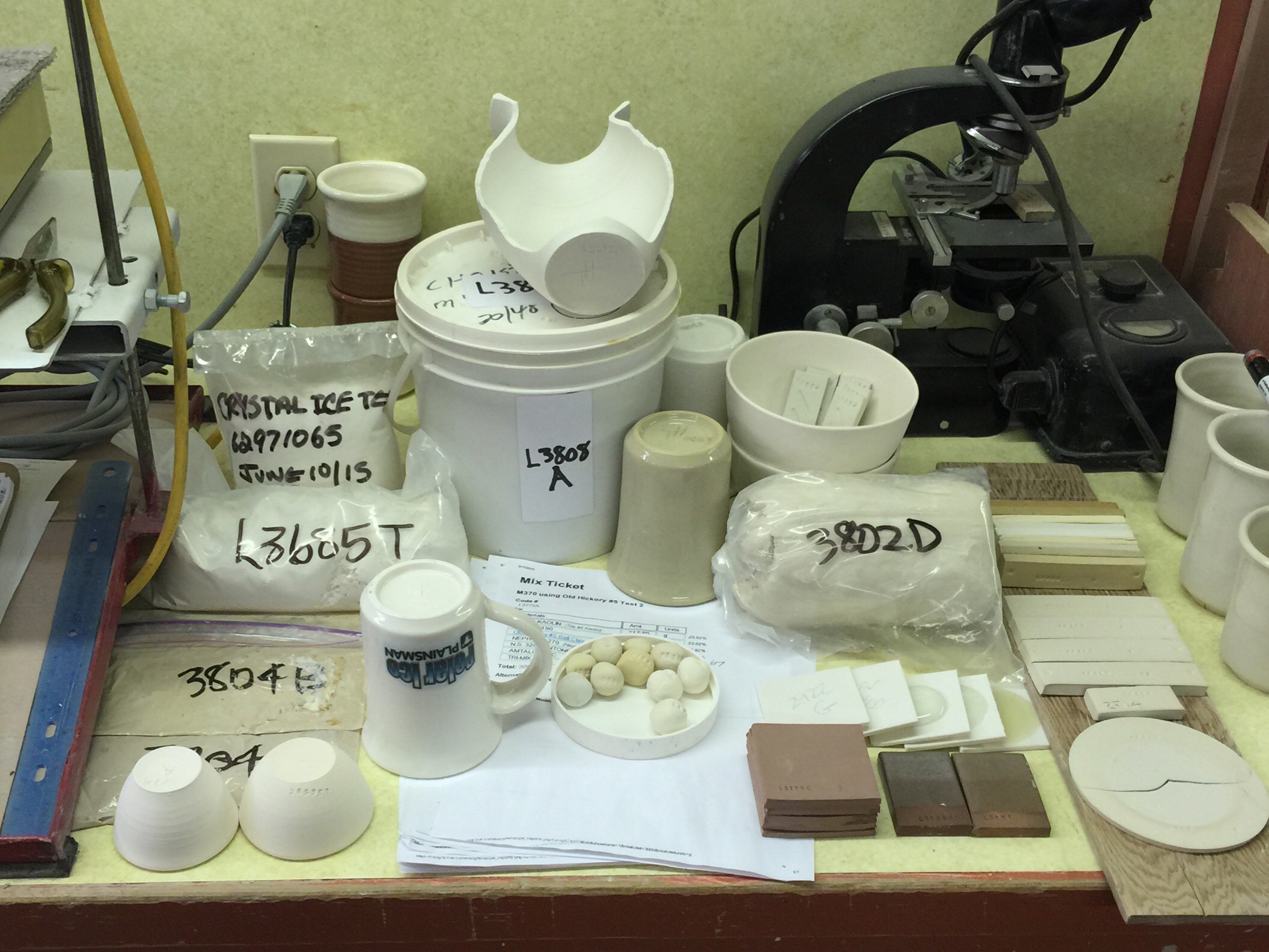| Monthly Tech-Tip | No tracking! No ads! | |
Fitting an engobe to have the same firing shrinkage as the body
The fired shrinkage of a clay can be measured accurately - and compared with that an engobe. Engobe-fit on terra cotta is very important because the bond is sintered, not glassy. These test bars show how this terra cotta body, L4170B, performs from cone 8 down to 06. Using the SHAB test procedure, I measured the dry and fired lengths of each bar and recorded the data in my Insight-live group account (it displays like the chart shown here). I compiled the same data for a super-white engobe, L3685Z3. Its calculated firing shrinkage came in much lower at all practical temperatures. At the target temperature of cone 02 a 5% addition of Ferro Frit 3110 increased the firing shrinkage from 2.1% to 5.5% (while the red body is 4.3%). To better the match I adjusted to 3% frit. What about matching the thermal expansion? I don’t have a dilatometer so I slurried up the engobe and used it as a body, it fits the same glazes without crazing or shivering (demonstrating they are under some compression).
Related Pictures
An incredibly white engobe on terra cotta that produces durable and decoratable low fire ware

This picture has its own page with more detail, click here to see it.
I found seven secrets with recipe, process, glaze and firing to make durable terra cotta.
1. A lot of Zircopax, in this case 20% (for whiteness, opacity).
2. The whitest burning materials: New Zealand Halloysite as the kaolin and nepheline syenite as the feldspar.
3. 3% Veegum to gel the slurry (enabling low specific gravity for thin and even coating).
4. The recipe, L3685Z2, has 55% kaolin, that will certainly produce drying cracks. But 1% CMC gum stops that and makes it brushable. It even works on on bisque, I pour-applied it to the insides of these two slip-cast pieces, it drained to perfectly even coverage (in a very thin layer).
5. A terra cotta casting/throwing body to fit the engobe to (has the same fired shrinkage at a target temperature, e.g. cone 04): Initially I am using L4170B.
6. A clear glaze that fits and is transparent: Notice how much whiter the left one is, G3879. At the same thickness as the G1916Q on the right, it is more transparent, better transmitting the white of the engobe.
7. The right firing curve: The 04DSDH drop-and-hold schedule for defect free surfaces.
Code numbers are the key to organizing your studio or lab

This picture has its own page with more detail, click here to see it.
The new ceramics is about data! Everything here has a code number (in the form x1234) that members of our team can search in our group account at Insight-live.com. We write the numbers on the bottoms of pots, plastic bags of powders/liquids/pugged, buckets, glaze balls, mix tickets, test bars, tiles, glaze samples, drying tests, flow tests, sieve analyses, LOI/water content tests, etc. Glazed fired pieces can have up to three numbers, the body, engobe and glaze. If something is lacking a number it goes in the garbage because it teaches nothing and is therefore taking up pointless space.
How to decide what temperature to fire this clay at?

This picture has its own page with more detail, click here to see it.
This is an extreme example of firing a clay at many temperatures to get wide-angle view of it. These SHAB test bars characterize a terra cotta body, L4170B. While it has a wide firing range its "practical firing window" is much narrower than these fired bars and graph suggest. On paper, cone 5 hits zero porosity. And, in-hand, the bar feels like a porcelain. But ware warps during firing and transparent glazes will be completely clouded with bubbles (when pieces are glazed inside and out). What about cone 3? Its numbers put it in stoneware territory, watertight. But decomposition gases still bubble glazes! Cone 2? Much better, it has below 4% porosity (any fitted glaze will make it water-tight), below 6% fired shrinkage, still very strong. But there are still issues: Accidental overfiring drastically darkens the color. Low-fire commercial glazes may not work at cone 2. How about cone 02? This is a sweet spot. This body has only 6% porosity (compared to the 11% of cone 04). Most low-fire cone 06-04 glazes are still fine at cone 02. And glaze bubble-clouding is minimal. What if you must fire this at cone 04? Pieces will be "sponges" with 11% porosity, shrinking only 2% (for low density, poor strength). There is another advantage of firing as high as possible: Glazes and engobes bond better. As an example of a low-fire transparent base that works fine on this up to cone 2: G1916Q.
Videos
Links
| Glossary |
Engobe
Engobes are high-clay slurries that are applied to leather hard or dry ceramics. They fire opaque and are used for functional or decorative purposes. They are formulated to match the firing shrinkage and thermal expansion of the body. |
Got a Question?
Buy me a coffee and we can talk

https://digitalfire.com, All Rights Reserved
Privacy Policy

